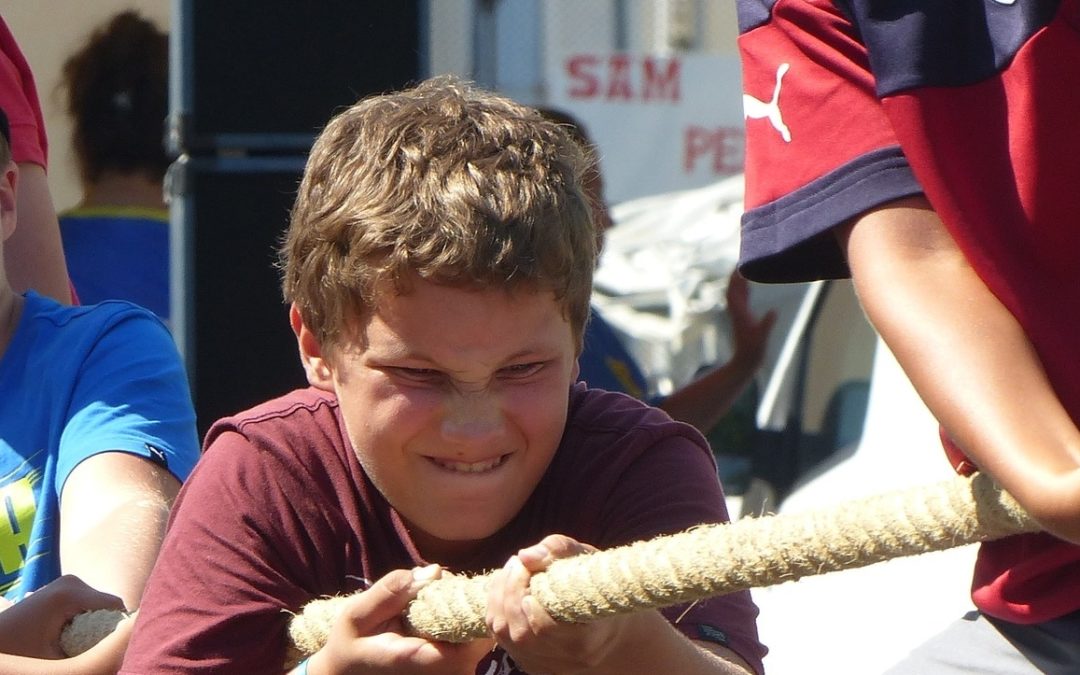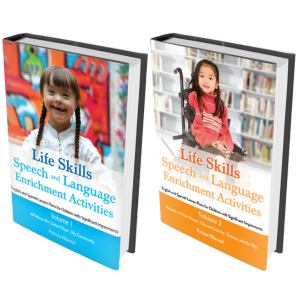There is an aspect of planning speech therapy for children with multiple disabilities that feels like a huge game of tug o’ war. It’s difficult enough right? We have students who have difficulties communicating and on top of that they have:
- Visual Impairments
- Hearing Impairments
- Mobility Needs
- Intellectual Disabilities
If it were therapy alone that we were worried about, I think that most of us would still be in pretty good shape. However, it’s the questions that we have to answer before therapy even begins that really exacerbate the problem:
Do we see them individually or in a group?
In the classroom or in your speech room?
Do the special education assistants work with us or do we work alone?
Do we use low-tech or high-tech AAC based on whether the classroom or home will adopt it?
This is where tug o’ war comes to mind for me because there are real people on the other side of the rope from us. The special education teachers, the general education teachers, the special education assistants, and the parents have a huge influence. If we don’t communicate and collaborate, we can end up on opposite sides of the rope. Our ability to collaborate and get on the same page influences how successful we are at teaching strategies for students with multiple disabilities.
| WHEN THINGS GO WELL | WHEN THINGS DON’T GO WELL | |
| Where? | We can work in the classroom so that we don’t have to spend precious time in transit. | We are asked to take every child out of the classroom regardless of mobility or behavior challenges |
| Who? | We address the parents’ or teachers’ greatest concern and work along side the aide or nurse. | We work alone. Others leave the room to do other things when we come. |
| When? | We join classroom sessions if possible | We are given a pretty strict window for picking up our students. |
| How? | We provide group or individual therapy. This can be during a class session like morning circle. | Therapy happens away from the classroom |
| What? | We use classroom goals, themes, and materials. | Classroom materials or themes are not shared. |
| What? X2 | There is buy-in around AAC. | AAC is abandoned outside of speech therapy time and devices are normally dead. |
So it’s not just “speech therapy with children with multiple disabilities.” It’s never that simple. The great news is that there is one tool at our disposal that helps us to lay the ground rules for how we can enjoy a highly collaborative environment.
MODIFICATIONS!
It doesn’t get much better than when we make huge gains TOGETHER in a life skills or special education classroom.
Modifications for Students with Multiple Disabilities
Modifying lessons for children with different levels of abilities and multiple impairments is a challenging task for anyone. Here are some things to remember when planning for such a diverse group of students:
Structure:
Choose which students need to be seen individually and which students can benefit from being part of a group based on the classroom dynamic and their level of communication ability. Communication abilities can be broken down into:
- Non-verbal
- Non-verbal and intentional with gesturing
- Low verbal (1-2 word utterances)
- Verbal
Plan:
When preparing lessons for the classroom, keep in mind ways to modify so that all students can participate and target their goals. For students with physical impairments: keep things mobile. This will allow students to easily access materials.
- Modifications for students that have visual impairments: Make sure to include plenty of auditory and tactile input during your lessons. Sound clips and manipulatives are great.
- Modifications for students with auditory impairments: Large visual aids and signs should be incorporated into lessons.
- Modifications for students with AAC devices: Learn about the devices used and how the students use them. You may need to acquire templates for the device or program the device to enhance a lesson and increase communication.
- Modifications for students with Behavior Plans: Set clear and consistent rules. Create a separate set of materials to be used individually by the student for a sense of responsibility and purpose.
Develop a Routine:
Find ways to keep your sessions consistent so that students know what to expect. You may choose to begin a session and end a session the same way every time. A great way to start a session is by choosing a “Question of the Day” or targeting a “Sound of the Day.” End your sessions with the same song or chant. This will provide a clear start and finish to speech therapy.
Ask for Help:
Collaboration is key for successful execution of a lesson that requires multiple components. Make sure teachers know how you are planning to modify for each student, ask for their input, and most importantly, ask for help to carry this out.
Don’t be afraid to revise and change throughout the year if you think your students would benefit from something else. Make sure to keep the lines of communication open with teachers to continually assess and make changes as necessary. If something doesn’t work, try and try again.
Why modifying speech therapy for children with multiple disabilities is so important.
We are busy people. Crazy busy. You, me, and any educator we interact with. Often times I feel that when we approach our colleagues about serving a student together, the first place their mind goes to is everything that they have to do.
Really no different than us, right? So it makes sense that a seasoned professional is going to protect their work space, their schedule, and the people assigned to them to help out.
If we approach our conversations based on the best outcomes we could imagine for the child AND speak in terms of what is on the IEP (e.g. modifications) then we are not adding to their workload. We are helping them get their workload done!
More Resources:
Language Intervention for School-Age Children with Down Syndrome




Where do I start with teachers that want their students pulled out of the life skills classroom? How about a student who has an AAC device but it is not used in the classroom?
Great and common questions.
First, there is a free CEU course on working in a Life Skills Classroom. It is perfect for your situation and great for anyone working with multiple disabilities: Life Skills Course.
We are typically battling two potential issues. 1) Teachers are protective of their classroom, aides, and time. I feel rightfully so. I would suggest finding a time when you can spend some time in there, listen to the exchanges that are going on, and help improve communication with some simple suggestions so that you are seen as part of the team (e.g. parents, nurses, aides, teacher) and not just a visitor. Working one-on-one in the corner might be a next possible step.
Aug Comm is really tough. When there is no buy-in about using AT, I scale it back to use a low tech communication board. You can make several copies to put on the desk, in back packs, taped to the wheelchair tray, etc. Teach with that, model to the teachers how to do it, and choose activities that meet THEIR special ed goals. You can download our favorite in-color core vocab map on the Speech Therapy Materials page.